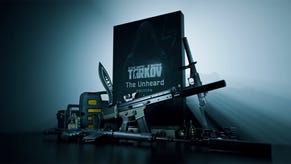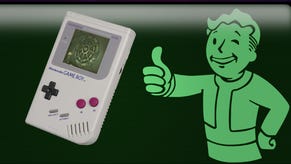GDC: amBX chief talks consoles, GDC and why PC gaming is "the testbed"
While catching up with the entire games community at GDC '08, we took some time out to talk about where Philips have now got to with their amBX lighting and multimedia feedback technologies, first revealed to the public in April 2005. The amBX stand dominated the main show floor at GDC '08, and was showing off a number of the games now enabled with the tech, each one providing a contrasting visual and tactile experience.
We spent some time playing Quake 4, which was backed up with four ambient lighting units (one of which doubled up as speakers) four fans for “blast” type feedback, and a rumbling keyboard wrist pad. Looking at all this from a distance, it's easy to dismiss until you have a play with the tech itself. After a few minutes the ambient effects do seem to tune you into the game, and the various feedback pulses seem quite natural. Philips are doing something quite unusual with this project, and it soon becomes clear that this testbed of technologies for PC gamers is actually part of a much bigger picture for what the tech giant want to achieve. We talked to Philips amBX's chief marketing officer Jo Cooke, and asked her what the company that invented the lightbulb was up to in the gaming space.
Full interview after the link.
videogaming247: Let's start with a bit of background and context for all this. You're spearheading something much larger with amBX aren't you?
Jo Cooke: Well, yes. When this was at the research and development stage we hadn't decided which market we were going to introduce it into. As a technology it can be applied in so many places; think about lighting, for example. It can be used to control many different applications to do with LED lighting and solid-state lighting. You can do so much more with this kind of technology than just lighting your room, and the minute you can do more with your light you'll also need a way of being able to control it. That can get really complex, and that's where amBX can be applied.
But you also need a context for this, so let's put it in the context of the technology you use to entertain yourself, or even the context of a business where you want to use lighting to highlight a different product by the hour – with amBX you can easily rotate lighting around as you require, you can shine a light on particular products. This can be set up in one store and then distributed via a PC to others. There are huge possibilities.
The most important thing, however, was how consumers would experience this right now, rather than in some theoretical “home of the future”. The one market in which they were already using controllers and output devices to enhance their experience was the games market.
One of themes at this conference seems to be a focus on output within games – both in technology and design, with developers concerned about how to allow gamers to feel the effects of their actions and “own” the output...
Yes, and for years the focus has been on input. It's been about how you can control what is going on in the game. I think that's part of the drive towards realism, which has resulted in some complex games, but not necessarily in a more immersive experience. Realism does mean immersion – think about how music creates environment, mood, feeling or atmosphere, how you can change everything with a soundtrack. AmBX is more than a soundtrack, it's an ambient soundtrack. It's a...
Visiontrack?
Cooke: Well there's more than that. We could call it Sensory Surround, rather than Surround Sound. It's an experience track. It can be light, but it can be rumble. It can be anything else really, all delivered through the script. Whatever can deliver an experience can be scripted.
How did you go about introducing this technology to the game developers who now support it?
Initially it was it just a case of getting hold of developers and putting them in front of it, like here at GDC. The first session was here a few years ago, when we had the first demos behind closed doors. (We were still working on how to protect the the technology at that stage, and we didn't want everyone to know what we were doing.) But every time we show developers what we do, their brain goes into overdrive. They're often unsure about how the technology applies to them, or whether they or their audience is ready for it, but the interest is there. Now that we have end consumer product it's much easier to demonstrate.
We also found that people have always asked, “When can I get this in my living room?” That's out long term vision too, for the system in your living room or your kitchen to integrate. We want you to walk into a room with your PSP and have the lighting join in with the experience of the game – that idea is so compelling.
We truly believe that gamers are the people looking for this kind of immersion. When we come to the point where we can do this stuff then we know the audience is there. It hasn't been hard to convince developers about the long term.
Do you have a vision for how this tech is going to turn up in things we're going to buy? I mean, this isn't just going to be confined to Philips' own kits, is it?
When we were first making the devices, these Heath Robinson devices we created to demonstrate it, the R&D guys have a vision of how to demonstrate the concept with actually having the hardware – the were painting lightbulbs and hooking up fans. They knew it was a good direction to move in within our industry. The original devices have to be sold internally to our other groups within Philips – the lighting group within Philips is looking at this now. There's no reason why those beautiful lights you buy for your home can't communicated with your PS3 or your PSP. It's not much of a leap to have this stuff join in with entertainment. It'll be an absolute lighting solution, either as something built into the fabric of a new home, or something installed in an older home. We have an agnostic view about connectivity too – it could just be a USB plugin device on your PC, it could even be found in any number of wireless devices.
We have found other applications for the scripts too, like the force feedback vest and helmet that is being demonstrated here, or even other rumble apps. There are some hi-tech theatrical applications that can be installed in the home and controlled by amBX, like big, rumbling subwoofers. We use all this in our demos.
This reminds me of a conversation I had with David Soul [Starsky and Hutch - Ed] a few years ago, where he was telling me that theatre had to change and embrace lighting and audio tech to compete with cinema and videogames...
Exactly! We've been talking to planetarium companies, because we can solve so many of their problems. They can just write amBX scripts to make the planetarium lighting entirely dynamic. We could even do that in the home – we're not dictating the physical set up or environment. What amBX does is recreate what is scripted based on what you've got hooked up to it. If you've got the fans hooked up to have an explosion come from behind you, then it can recreate that, if you haven't got that installed it won't do it. We're not saying “you must put this here and that there”. We're expecting game developers might say “this might work best with x and y” but we're not going to dictate what people buy for amBX setups.
We think there will be a time when more and more devices have amBX technology installed – TVs and so on.
So all this works on PC now, but what's going to happen with console set ups?
We're working with developers at the moment to see how amBX can integrate into games on the next gen consoles, but we're also talking to the hardware manufacturers to see exactly what kind of devices they're thinking of producing for these gamers. Setting up on a PC is one thing, but on a console it's quite different – you're not sat at a desk.
Also, PC gamers spend more on these kind of products. They're already buying 5.1 speakers and graphics cards. They're the kind of consumers who take on these technologies quite readily. Console gamers spend less.
But they'll spend on a great big TV?
Cooke: Yes, they'll buy an expensive TV and that's a natural progression. They may well spend it if they think there's an additional use – not just gaming, but movies and music. It's a bigger picture – the ambi-lights allow you to look at a bigger picture. We'll be creating a product that allows ambi-light presentations alongside your photo slideshows, for example. It won't just be about gaming on PC.
And there's more than just fans and lights here, isn't there? I've heard tell of smellovision, or dry ice machines?
We've employed a lot of technology that already exists in the market place – misters, for example – and simply used our drivers to control them. We have used dry-ice machine in big demos, and if a dry-ice machine manufacturers wanted to create a device that used amBX devices alongside the dry-ice all they would have to do is license the technology from us.
So amBX is really just a way of centralising control over loads of different output devices?
Absolutely. We call it an “enabling technology”. Hardware companies who want to exploit the connection between games, movies and music won't have to do this extra work each time, because there's this connective layer of our middleware. We do all the work for them, all they have to do is create good products. If something is amBX enabled, it'll work with any amBX content. It has opened a whole new realm of possibility for peripheral manufacturers.
How useful is GDC to you?
Cooke: It's one of the best places for us to demonstrate amBX. It's quite an intimate environment to be able to get to show what we can do to developers and publishers, and much more useful that some of the bigger shows. We do a lot of business, and each year at GDC we find ourselves making progress. It's really fruitful to be able to work with those companies, like Ubisoft with Far Cry 2, who really take pride in being at the forefront of technology. You can see the results in the reactions of the people coming off the stand.
Do you really think the PC hardware market is big enough to showcase what you want to talk about with amBX? We seem to have covered a lot of ground outside just PC gaming...
I do, yes. It is enough for the moment. For us as a business it won't be enough, we need the living room, the home cinemas, but right now we have to focus ourselves on one thing. We can't run around saying “oh look at all the possibilities”, we just have to get this one thing right. The PC gaming industry is small enough that we can get around and talk to everyone, and big enough that we know we're making a difference. Long term we'll expand much more.
PC gaming is just the testbed...
Yes, PC gaming is the testbed. We can get results right away because it's an open platform. The consoles are closed off, so it's quite difficult for us to have any control on putting new software on them until we've demonstrated what we can do. On the PC we can constantly produce new technology and give it straight to the consumers. PC gamers will play with this stuff and tell us what they think.
Go and look at our forums and you'll see this hardcore PC gaming base who are active with the amBX technologies. They're telling us what they want, they're modding the technologies and testing the drivers. They're brilliant as opinion formers and in telling us what people want. Ultimately though, we will need to access a much bigger audience.
PC gaming isn't going to go away, and for us it's the audience we approached by default, rather than by design. They're a forgiving audience, because they're used to software and hardware that doesn't quite work, basically. They're tolerant because even the biggest names in software to PC that doesn't quite work. Imagine if you released a TV that didn't quite work properly and you have to work around the glitches – you just wouldn't accept that.
The PC is the format for the tinkerers, it's true.
And there's lots of tinkering potential with amBX. We've had pictures turn up on the forums where people have bolted in their own huge fans in places of our ones, great big things that will blast them out of their seat! PC users are looking at what we've done, finding uses for it, and then coming back with suggestions for other applications.
We've just installed some tech to allow people to use the PC with media players and applications like Google Earth. We want to release this to web developers, so that there can be scripts for the website. Bright sunshine on your weather reports, or a breeze from the fans if it's going to be windy. You simply can't do that on the consoles yet. We have a hardcore, educated customer base that will pioneer how amBX is used.
Our money man said he was looking forward to the day when he could be sitting at his amBX-enabled PC and he could tell when our share price went up just from the reaction of the lighting units. The guys said, “well if he wants that we'll write the script for him”, so now he has his amBX connected to the Philips share-price reader – only he has it – and now when the shares go up it gets all bright and beautiful, and when it goes down the lights dim, the fans kick in, all to make it a little more miserable. That's such a simple application, and it's the kind of thing that we want to end consumers to write themselves.









.png?width=291&height=164&fit=crop&quality=80&format=jpg&auto=webp)